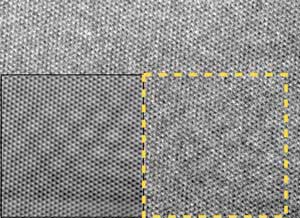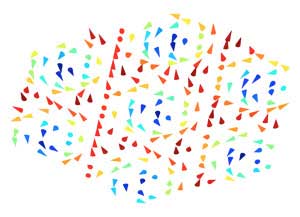| Mar 27, 2020 | |
Skyrmions seen in a kagome lattice(Nanowerk News) Whirlpools of magnetism that are just a few nanometers in diameter have been created and imaged in an exotic crystal lattice by RIKEN physicists (Nature Communications, "Skyrmion phase and competing magnetic orders on a breathing kagomé lattice"). Such skyrmions, as they are known, could one day be used as computing bits that can be tightly controlled by magnetic fields. |
|
| Electrons have their own intrinsic magnetism, called spin, making each one act like a small magnet. In most materials, these spins point in random directions. But when they are ordered, a material can display magnetic properties. | |
 |
|
| Figure 1: Electron microscopy image showing a skyrmion lattice in a crystal with an inversion center. The square indicated by the dashed yellow line has been filtered to reveal skyrmions in the square on the left. | |
| “There are an infinite number of crazy possible spin arrangements,” says Max Hirschberger of the RIKEN Center for Emergent Matter Science. “Skyrmions involve a special ordering, in which the spins twist around like tiny tornadoes.” | |
| Physicists are interested in skyrmions because they can be isolated within the material and moved around individually, using small electric currents, as though they were particles in their own right. The hope is that they could act as computing bits that can store data for spintronics applications. But physicists must first find materials that can carry small and stable skyrmions. | |
| Most skyrmions discovered to date are larger than 10 nanometers in diameter. To beat this, theorists have predicted that crystals with an inversion center can host tinier skyrmions, a stark contrast to the polar or chiral structures of previously studied skyrmion materials. The present crystal, which harbors magnetic ions arranged in a special ‘star of David’ configuration called a kagome lattice, is one of the first examples of this new family. | |
| Last year, the team at RIKEN generated skyrmions in a crystal with an inversion center for the first time. But they could not directly image the magnetic vortices (Science, "Skyrmion lattice with a giant topological Hall effect in a frustrated triangular-lattice magnet"). | |
| Now, they have generated skyrmions that are just 2.8 nanometers in diameter and directly imaged them with a transmission electron microscope—the first time skyrmions have been visualized in this kind of material (Fig. 1). | |
 |
|
| Figure 2: A schematic representation of a nanoscale skyrmion lattice. Each arrow indicates the direction of an electron spin on an individual atomic site in the kagome lattice. | |
| The experiments were performed at -253 degrees Celsius, which is too cold for everyday applications. “The search is now on for tiny skyrmions that are stable at higher temperatures,” says Hirschberger. | |
| Beyond applications in data storage, materials carrying skyrmions could also have useful optical properties, which are an important direction for ongoing and future research. Today, engineers use materials whose optical properties can be controlled electronically to build windows in airplanes, for instance, that darken when an electric current passes through them. “We believe the control of advanced optical properties through complex magnetism, rather than electrical control, could open the door for a new direction in materials science and engineering,” says Hirschberger. |
| Source: RIKEN | |
|
Subscribe to a free copy of one of our daily Nanowerk Newsletter Email Digests with a compilation of all of the day's news. |
